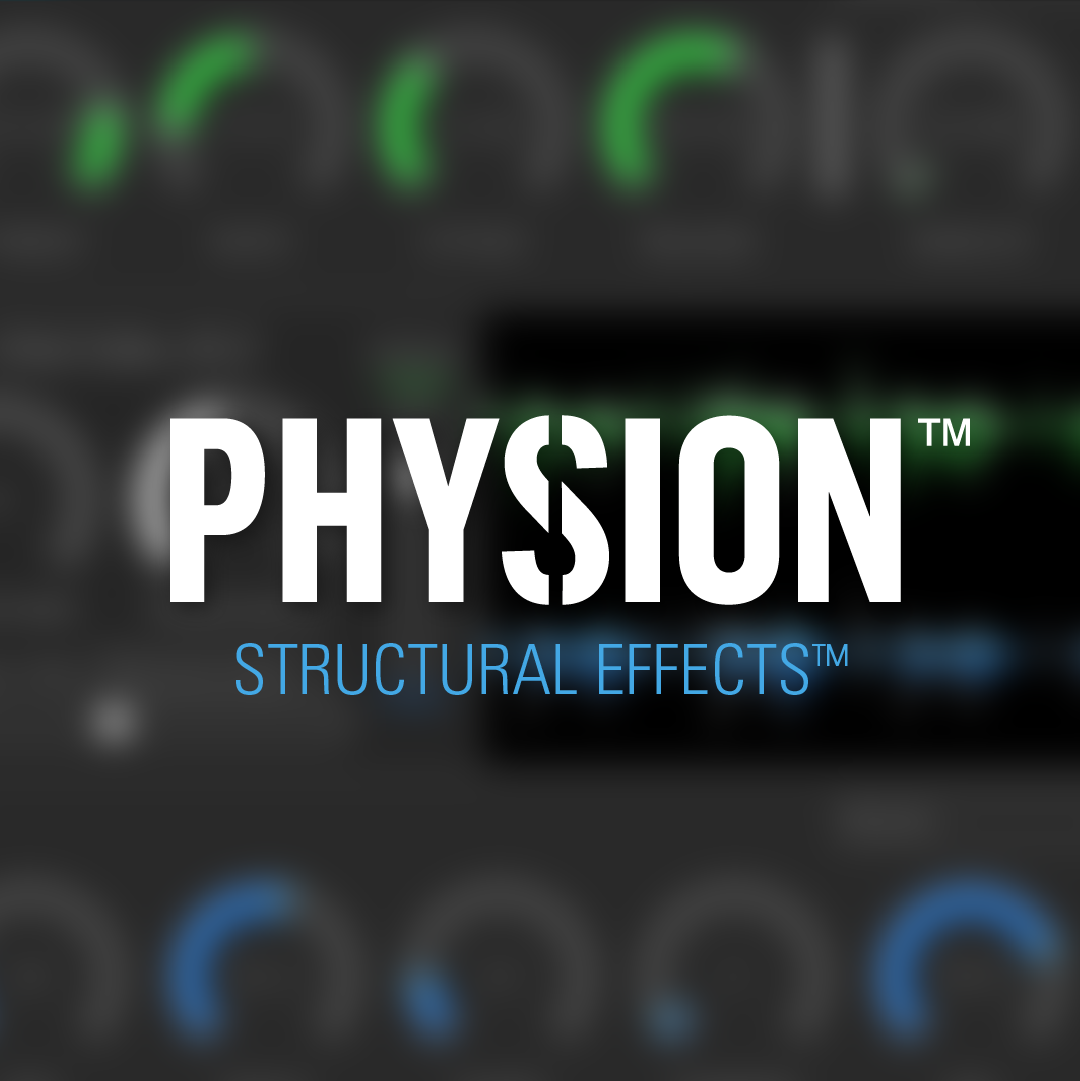Notice: A new version of Physion is available here.
The Ultimate Creative Tool
Physion is the first plug-in to use our ground-breaking Structural Effects technology — A new method for processing audio. With Physion, you can split a sound into its transient and tonal parts, independently manipulate them using Eventide’s world-class effects and then fuse them back together. With the ability to add effects and dynamic controls to the transient and tonal sections, you can produce a wide range of sounds, from the subtle to the extreme.


Features
- Split audio into “Transient” and “Tonal” components
- Radically re-shape a sound by soloing the Tonal and Transient channels. Tighten up drums by dropping the tonal section, or tune a guitar into an ambient sweep by losing the transients.
- Split, modify and reassemble any sound
- Fine-tune the split using the four “Structural Split” controls.
- Six Transient effects available: Delay, Tap Delay, Dynamics, Phaser, Reverb, Gate + EQ
- Seven Tonal effects available: Delay, Compressor, Pitch, Chorus, Reverb, Tremolo, EQ
- Waveform display for clear tracking of Transient/Tonal audio in real-time
- Artist presets from Richard Devine, Chris Carter, Suzanne Ciani, Joe Chiccarelli, John Agnello, Stewart Lerman, Steve Rosenthal, Kaitlyn Aurelia Smith and more
Countless Applications

Sound Design
Physion is a versatile tool for sound designers. Splitting and manipulating audio allow you to create and explore sounds never heard before. Remove transients from pianos or guitars to create bowed sounds, or go even further by adding extreme effects to the independent channels.

Drum Tuning
Physion allows you to easily re-tune a drum without affecting the transient. Delay the cracking transient of a rimshot while leaving the tonal ring as-is. Solo out the transients to tighten up a sound and add some compression to tighten further.

Articulation
Physion’s structural split can be used to modify vocals in subtle or drastic ways. Emphasize or reduce sibilance, add or remove resonance, or turn robust vocals into whispers.

Transient Shaping
Physion is not a traditional transient shaper — it’s a transient separator. It goes beyond what has been possible by allowing you to surgically tune the transient and tonal response independently.

Audio Restoration
Remove any unwanted tonal ring and hiss, or just reduce it with compression/expansion. Beef up the transients from old instrumental recordings to improve presence in a mix without squashing the life out of the tonal material.

Loop Mangling
Use various instances of Physion to morph and transform your loops using independent tonal and transient delays.
Bonus Offer
Eventide customers get FREE access to top-notch video tutorials created exclusively for Physion by our friends at Groove3!
Visit Groove3 to learn more.
Bonus Offer
Eventide customers get FREE access to top-notch video tutorials created exclusively for Physion by our friends at Groove3!
Visit Groove3 to learn more.
Explore the Split

Smoothing
SMOOTHING controls the speed of the decision-making process, preventing it from making too fast a decision either way. This is useful for trimming out unwanted transient chirps or smoothing rough transitions.
Transient Decay
Turning up TRANSIENT DECAY preserves energy in the transient stream, further thickening up the transient tail as well as increasing the auto-swell on the tonal stream.
Focus
Adjust the FOCUS control to ‘fine tune’ the parsing of the sound based on contextual and musical desires. FOCUS forces the method to favor one stream over the other. Sliding FOCUS toward tonal will result in a more staccato transient stream. Sliding FOCUS toward transient will result in heavier transient tails along with tonal auto-swell. Extreme settings will push the entire signal to either the transient or tonal stream. The FOCUS control can be used to make subtle modifications like de-essing, de-reverberating, or reducing pick noise by adjusting transient and tonal gain.
Source Type
Selecting SOURCE TYPE sets the under-the-hood expert tunings that prime the analysis and decider for a natural sounding split of a given source.
Explore the Effects
Six Transient Effects

- Delay — A standard Delay echo effect with Tempo Sync capability and low and high-cut filtering
- Tap Delay — A multi-tap delay-line with Tempo Sync capability. Useful for rhythmic delays, wacky comb filtering, volume swells, or unique reverberant sounds.
- Dynamics — A combined Compressor/Limiter and Expander/Gate (function is determined by Ratio control)
- Phaser — A classic multi-stage allpass based Phaser effect, which can be controlled via LFO or Envelope
- Reverb — A room Reverb designed with high echo density, imparting a fast and smooth build-up of reflections. This pairs nicely with transient sounds to create a sense of space without obvious echo slap back.
- Gate + EQ — A Gate followed by a 3-band overdrive-able EQ
Seven Tonal Effects

- Compressor — A standard Compressor/Limiter
- Chorus — Multi-voiced chorus with randomized modulation
- EQ — A 3-band overdrive-able EQ
- Delay — A standard Delay echo effect with Tempo Sync capability, modulation, and low and high-cut filtering
- Reverb — A large space Reverb designed with lower echo density (compared to Transient Reverb) and targeted high modal density with little to no modulation to avoid a chorusing sound on the tails. This allows the tonal audio to breathe in the space, yet evolve into dense pad-like reverberant tails.
- PitchShift — A 3-voice Pitch Shifter with +/- 1 octave shift per voice and an overall fine tuning control. Useful for retuning drums, creating harmonies, or micropitch chorusing/double-tracking all without transient slap back or smearing.
- Tremolo — A standard Tremolo effect which is driven by an LFO in (optional) combination with the Envelope of the plug-in’s input
Reviews
Perfect tool to apply a detailed approach.
Fission [Physion] is the perfect tool to use when you are seeking to apply a more detailed approach to your engineering… It’s an idea that no other company to our knowledge has attempted, and Eventide has executed their idea resulting in the perfect plugin for this case.
Jimmy Byrne
All Things Gear
Artists Using Physion












System Requirements
Compatibility
Patented Technology
The Physion product is covered by United States Patent No. 10,430,154.






